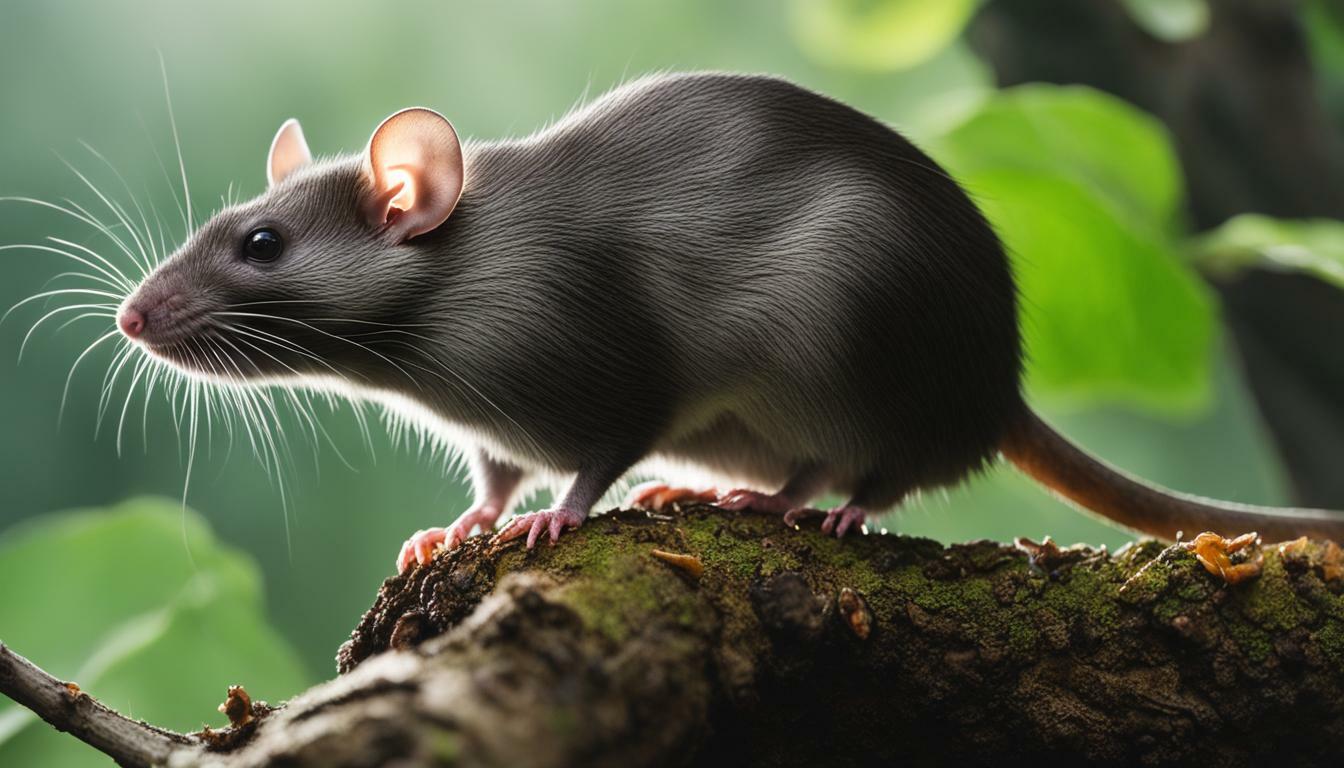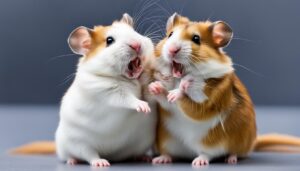Are rats known to eat ants or are these tiny insects safe from their voracious appetites?
Key Takeaways
- Rats are omnivores and will consume both plant-based and animal-based foods.
- They have a diverse diet that includes fruits, nuts, grains, insects, and even human food and garbage.
- Rats are opportunistic eaters and will take advantage of available food sources.
- There is no specific information regarding rats eating ants.
- However, rats are carriers of diseases and can pose a threat to homes and human health.
Understanding Rat Diet
Rats are omnivores, meaning they have a diverse diet that includes both plant-based and animal-based foods. They are opportunistic eaters and will consume fruits, nuts, grains, insects, and even human food and garbage. The two most common rat species in Michigan prefer different types of foods, with Norway rats favoring foods high in fat, protein, and sugar, while black rats are more interested in fruits and nuts.
Rats are careful with new foods and will sample small amounts before eating them. This cautious approach helps them determine if a particular food is safe for consumption. Certain foods that rats dislike or are toxic to them include citrus fruits, green bananas, green potatoes, rhubarb, and blue cheese. It’s important to note that rats also have a tendency to chew on wood, plaster, and electrical wiring in order to keep their teeth from getting too long.
One of the key characteristics of rats is their strong sense of smell, which allows them to locate food sources quickly. This sense of smell, combined with their ability to fit through small cracks and openings, makes it crucial to seal potential entrances to homes and buildings. Keeping rats out is important not only because they can cause damage, but also because they are carriers of various diseases.
| Rat Species | Preferred Foods |
|---|---|
| Norway rats | Foods high in fat, protein, and sugar |
| Black rats | Fruits and nuts |
“Rats are careful with new foods and will sample small amounts before eating them.”
Preventing Rat Infestations
In order to prevent rat infestations, it’s important to take certain precautions. Sealing all potential entry points, such as cracks in walls, gaps around pipes, and openings in doors and windows, can help keep rats from entering your home. Additionally, practicing proper hygiene by keeping food stored in sealed containers and regularly cleaning up any crumbs or spills can make your home less attractive to rats.
- Seal all potential entry points to prevent rats from entering your home.
- Keep food stored in sealed containers to minimize food sources.
- Clean up any crumbs or spills to reduce attractants for rats.
By following these preventive measures, you can reduce the likelihood of a rat infestation in your home and ensure a healthier living environment.
The Opportunistic Nature of Rats
Being opportunistic eaters, rats will readily consume insects like ants if presented with the chance. Rats are omnivores, meaning they have a diverse diet that includes both plant-based and animal-based foods. They are known to eat fruits, nuts, grains, and even human food and garbage. Insectivorous rats, in particular, have a fondness for insects and will actively seek them out as a part of their diet.
Rats are careful when it comes to trying new foods. They will often sample small amounts before consuming them fully, which explains their cautious approach. This behavior helps them avoid potentially dangerous or toxic substances. However, ants are generally safe for rats to consume, and they provide a good source of protein and nutrients.
It is worth noting that different rat species may have their own preferences when it comes to food. For example, Norway rats, one of the most common rat species, prefer foods that are high in fat, protein, and sugar. On the other hand, black rats are more inclined towards fruits and nuts. Understanding the specific feeding preferences of different rat species can help in implementing effective pest control strategies.
While rats may consume ants as part of their diet, it is important to address any rat infestations promptly. Rats can enter homes through small cracks and openings, so it is crucial to seal off potential entrances to prevent their entry. Rats are carriers of various diseases, and their presence in homes can pose health risks to humans. Maintaining proper hygiene, eliminating potential food sources, and practicing proactive pest control measures are key to preventing rat infestations and ensuring a safe living environment.
| Foods Rats Dislike or Are Toxic to Them |
|---|
| Citrus fruits |
| Green bananas |
| Green potatoes |
| Rhubarb |
| Blue cheese |
The Roles Ants Play in Rat Diet
While ants are a common food source for many animals and insects, their place in the rat diet is a subject of interest. Rats are known to be opportunistic eaters, consuming a wide range of foods, including insects like ants. However, the extent to which rats actively seek out ants as prey is still a topic of debate among experts.
According to research, rats are more likely to consume ants if given the opportunity. Ants provide a good source of protein and are relatively easy for rats to catch due to their small size and slow movement. Rats are agile predators and can quickly snatch up ants that cross their path in search of food.
However, it is important to note that ants are not a primary food source for rats. Rats have diverse dietary preferences and will consume a variety of plant-based and animal-based foods. Their diet can include fruits, nuts, grains, insects, and even human food and garbage. Ants may be a part of their diet, but they are not the sole focus of their feeding habits.
In conclusion, while rats are known to eat ants, their diet is not solely dependent on them. Rats are opportunistic eaters and will consume a range of foods based on availability. Ants provide a source of protein for rats, but they are not their primary prey. The role of ants in the rat diet is just one piece of the larger picture of their feeding behavior.
Rat Foraging and Ant Predation
When it comes to foraging, rats are known to display certain predation behaviors towards ants. As opportunistic eaters, rats have a diverse diet that includes both plant-based and animal-based foods. While ants are a common food source for many animals and insects, there is no specific information in these sources about rats eating ants.
Rats, especially the two most common species in Michigan, Norway rats and black rats, have distinct preferences when it comes to food. Norway rats favor foods that are high in fat, protein, and sugar, while black rats are more interested in fruits and nuts. However, both species have been observed consuming insects, including ants, if given the opportunity.
When presented with new foods, rats tend to be cautious and will sample small amounts before consuming them fully. This sampling behavior helps them avoid potential toxins or dangerous substances. It’s important to note that there are certain foods that rats dislike or are toxic to them, such as citrus fruits, green bananas, green potatoes, rhubarb, and blue cheese.
Rats have a strong sense of smell and can quickly locate potential food sources. They are agile climbers and can easily access food stored at height. To prevent rat infestations, it is crucial to seal all potential entrances into your home, as rats can enter through small cracks and openings. Additionally, practicing proper hygiene and keeping food securely stored can help deter rats from entering your property.
| Rat Foraging and Ant Predation |
|---|
| Rats are opportunistic eaters and will consume a variety of foods, including ants, if given the opportunity. |
| Norway rats prefer foods high in fat, protein, and sugar, while black rats are more interested in fruits and nuts. |
| Rats will sample small amounts of new foods before consuming them fully, helping them avoid potential toxins. |
| There are certain foods that rats dislike or are toxic to them, such as citrus fruits, green bananas, green potatoes, rhubarb, and blue cheese. |
| Sealing potential entry points and practicing proper hygiene are crucial in preventing rat infestations. |
Feeding Preferences of Different Rat Species
Different rat species may have varying preferences when it comes to their diet, including their interest in insects such as ants. While rats are omnivores and can consume a wide range of foods, their specific preferences can differ based on their species. In Michigan, for example, the two most common rat species are the Norway rat and the black rat.
The Norway rat, also known as the brown rat, favors foods that are high in fat, protein, and sugar. They are opportunistic eaters and will readily consume fruits, nuts, grains, and even human food and garbage. However, their diet mainly consists of foods that provide them with the necessary nutrients and energy.
On the other hand, black rats, also known as roof rats, have a stronger inclination towards fruits and nuts. They have a preference for plant-based foods and will actively seek out these food sources when available. While both rat species are known to consume insects, including ants, their interest in these small creatures may vary based on their respective food preferences.
It’s important to note that rats are careful when it comes to trying new foods. They will often sample small amounts before fully consuming them. Additionally, there are certain foods that rats dislike or are toxic to them. These include citrus fruits, green bananas, green potatoes, rhubarb, and blue cheese. It’s essential to be aware of these preferences and take necessary precautions to prevent rat infestations, as rats can carry diseases and cause damage to homes.
| Rat Species | Preferential Diet |
|---|---|
| Norway Rat | High fat, protein, and sugar foods |
| Black Rat | Fruits and nuts |
Rat Sampling Behavior
Rats are cautious when it comes to trying new foods, often sampling small amounts before fully consuming them. This behavior is a survival instinct that helps them avoid potential toxins or harmful substances. When rats encounter unfamiliar foods, they may nibble on a small piece to assess its taste and texture before deciding whether to continue eating.
This cautious approach to sampling allows rats to determine if a particular food is safe for consumption. They rely on their acute sense of smell to detect any potential dangers. If the sampled food is found to be palatable and safe, rats will then consume larger quantities.
Table 1: Examples of Foods Rats Dislike or are Toxic to Them
| Food | Reason |
|---|---|
| Citrus fruits | The acidic nature can irritate their digestive system |
| Green bananas | Contains high levels of resistant starch, which can cause gastrointestinal issues |
| Green potatoes | Contain solanine, a toxic substance that can be harmful to rats |
| Rhubarb | Contains oxalic acid, which is toxic to rats in large quantities |
| Blue cheese | The mold present in blue cheese can cause health issues for rats |
Rats’ cautious approach to trying new foods is an important factor to consider when implementing pest control measures. By understanding their sampling behavior, you can choose bait or traps that evoke their curiosity and encourage them to take a small bite, leading to successful pest control outcomes.
Foods Rats Dislike or Are Toxic to Them
While rats have a broad diet, there are certain foods that they either dislike or are toxic to them. It’s important to be aware of these items to prevent attracting rats into your home or property. Here are some examples:
- Citrus fruits: Rats are not fans of citrus fruits like oranges and lemons. The strong smell and taste of these fruits act as a deterrent for them.
- Green bananas: Rats prefer ripe bananas and are not likely to eat them when they are green.
- Green potatoes: Similarly, rats are not fond of green potatoes due to the presence of solanine, a toxic compound that can be harmful to them.
- Rhubarb: This tart vegetable contains oxalic acid, which is toxic to rats. They tend to avoid rhubarb in their diet.
- Blue cheese: While it may be a delicacy for some humans, rats are not inclined to eat blue cheese, possibly due to its strong and pungent odor.
It’s worth noting that rats have a habit of sampling new foods in small amounts before consuming them fully. This cautious approach helps them identify potential dangers or toxicity. Additionally, rats have a strong sense of smell, enabling them to quickly locate food sources. They are opportunistic eaters and will scavenge for meals, including human food and garbage. It is important to keep your surroundings clean, store food properly, and promptly dispose of waste to discourage rats from entering your property.
Rats can enter homes through small cracks and openings. Therefore, it is crucial to seal all potential entrances to prevent infestations. Not only can rats cause damage to your property by chewing on wood, plaster, and electrical wiring, but they are also carriers of various diseases. Taking preventive measures, such as sealing entry points, practicing proper hygiene, and eliminating potential food sources, will help keep rats at bay and maintain a rodent-free environment.
Rat Foraging Abilities
Rats possess remarkable foraging abilities, including a keen sense of smell that helps them locate food sources with ease. This sense of smell, which is far superior to that of humans, allows rats to detect even the faintest scents of potential food. This is particularly advantageous for them when foraging for plant-based and animal-based foods, as they can follow scent trails and locate hidden food sources. In addition to their sense of smell, rats also have sharp vision and excellent hearing, making them highly adept at finding food in various environments.
When it comes to foraging, rats exhibit a combination of cautiousness and curiosity. They are careful with new foods and will often sample small amounts before consuming them fully. This behavior helps them ensure the safety and palatability of their food. Rats are known to be opportunistic eaters, meaning they will consume a wide variety of foods to sustain themselves. They are omnivores, capable of eating fruits, nuts, grains, insects, and even human food and garbage.
While rats have the ability to consume insects like ants, there is no specific information available to suggest that ants are a significant part of their diet. Rats are known to consume a wide range of foods, but their preference may vary depending on the specific species. For example, Norway rats, one of the most common rat species in Michigan, tend to favor foods that are high in fat, protein, and sugar. On the other hand, black rats are more inclined towards fruits and nuts. It is important to note that the dietary preferences of rats can differ based on their habitat and availability of food sources.
Rats are not only resourceful foragers but also persistent scavengers. They have a tendency to chew on various materials, including wood, plaster, and electrical wiring, which helps them keep their constantly growing teeth in check. However, this behavior can cause significant damage to homes and pose fire hazards due to exposed wiring. It is important to address any signs of rat activity promptly and take necessary measures to prevent infestations.
| Rat Species | Feeding Preferences |
|---|---|
| Norway rats | Foods high in fat, protein, and sugar |
| Black rats | Fruits and nuts |
To protect your home from rat infestations, it is crucial to seal all potential entry points and practice proper hygiene. Rats can enter homes through small cracks and openings, so sealing these gaps is essential. Additionally, keeping food stored securely and disposing of garbage properly will help minimize the attractiveness of your property to rats. Remember that rats are carriers of various diseases, so keeping them out of your living space is of utmost importance for your health and well-being.
Preventing Rat Infestations
To prevent rat infestations, it is crucial to take proactive measures such as sealing all potential entrances and maintaining a clean environment. Rats are opportunistic eaters, and they can easily find their way into homes through small cracks and openings. Therefore, it is essential to inspect the exterior of your home for any gaps or holes and seal them with materials like steel wool or caulk. Don’t forget to check for openings around pipes, vents, and utility lines as well.
In addition to sealing entry points, keeping your surroundings clean is vital for deterring rats. Make sure to store food in airtight containers and promptly clean up any spills or crumbs. Regularly empty and clean garbage cans, and avoid leaving pet food out overnight. Rats are attracted to the smell of food, so maintaining good hygiene practices can significantly reduce the risk of infestation.
Another effective prevention method is eliminating potential rat habitats in your yard. Keep vegetation well-trimmed, as overgrown bushes and trees can provide hiding spots for rats. Clear away any debris or clutter from your yard, as it can serve as nesting material. Additionally, avoid leaving standing water or leaky pipes, as rats need water sources to survive.
| Foods Rats Dislike or Are Toxic to Them |
|---|
| Citrus fruits |
| Green bananas |
| Green potatoes |
| Rhubarb |
| Blue cheese |
If you suspect a rat infestation despite your preventive efforts, it is essential to seek professional pest control assistance. Rats can carry diseases and cause significant damage to property, so addressing the issue promptly is crucial for the safety and well-being of your family. Remember, prevention is always better than dealing with an infestation, so take the necessary steps to keep rats out of your home.
Conclusion
In conclusion, while rats are omnivorous and have a wide-ranging diet, the specific predation of ants is not definitively confirmed. Rats are opportunistic eaters and will consume a variety of foods, including fruits, nuts, grains, insects, and even human food and garbage. However, while ants are a common food source for many animals and insects, there is no specific information available to confirm that rats actively seek out ants as prey.
It is important to note that rats have different feeding preferences depending on their species. Norway rats, the most common rat species in Michigan, tend to favor foods that are high in fat, protein, and sugar. On the other hand, black rats are more interested in fruits and nuts. Rats are cautious when it comes to new foods and will sample small amounts before consuming them fully.
There are certain foods that rats dislike or are toxic to them. These include citrus fruits, green bananas, green potatoes, rhubarb, and blue cheese. Additionally, rats can cause damage to homes by chewing on wood, plaster, and electrical wiring to keep their teeth from getting too long.
To prevent rat infestations, it is important to seal all potential entrances to homes, as rats can enter through small cracks and openings. Practicing proper hygiene and keeping areas clean will also help deter rats from setting up nests. It is crucial to be cautious around rats as they are carriers of various diseases and can pose a risk to human health.
FAQ
Do rats eat ants?
While rats are omnivores and will consume a wide range of foods, there is no specific information indicating that rats actively seek out ants as a primary food source.
What is the diet of rats?
Rats are opportunistic eaters and will consume both plant-based and animal-based foods. They can eat fruits, nuts, grains, insects, and even human food and garbage.
Are there specific foods that rats dislike or are toxic to them?
Yes, rats may dislike or find certain foods toxic. Examples include citrus fruits, green bananas, green potatoes, rhubarb, and blue cheese.
Do rats sample food before eating it?
Yes, rats are careful with new foods and will often sample small amounts before consuming them fully.
What are the feeding preferences of different rat species?
Norway rats prefer foods that are high in fat, protein, and sugar, while black rats have a tendency to be more interested in fruits and nuts.
How do rats find food sources?
Rats have a strong sense of smell and can locate food sources quickly. They are opportunistic foragers and will explore their surroundings in search of food.
Can rats enter homes and buildings?
Yes, rats can enter homes and buildings through small cracks and openings. It is important to seal all potential entrances to prevent rat infestations.
Are rats carriers of diseases?
Yes, rats are carriers of various diseases and can pose health risks. It is important to keep rats out of homes and practice good hygiene to prevent infestations.
How can I prevent rat infestations?
To prevent rat infestations, it is important to seal potential entry points, keep food storage areas clean and secure, and remove any potential food sources.




